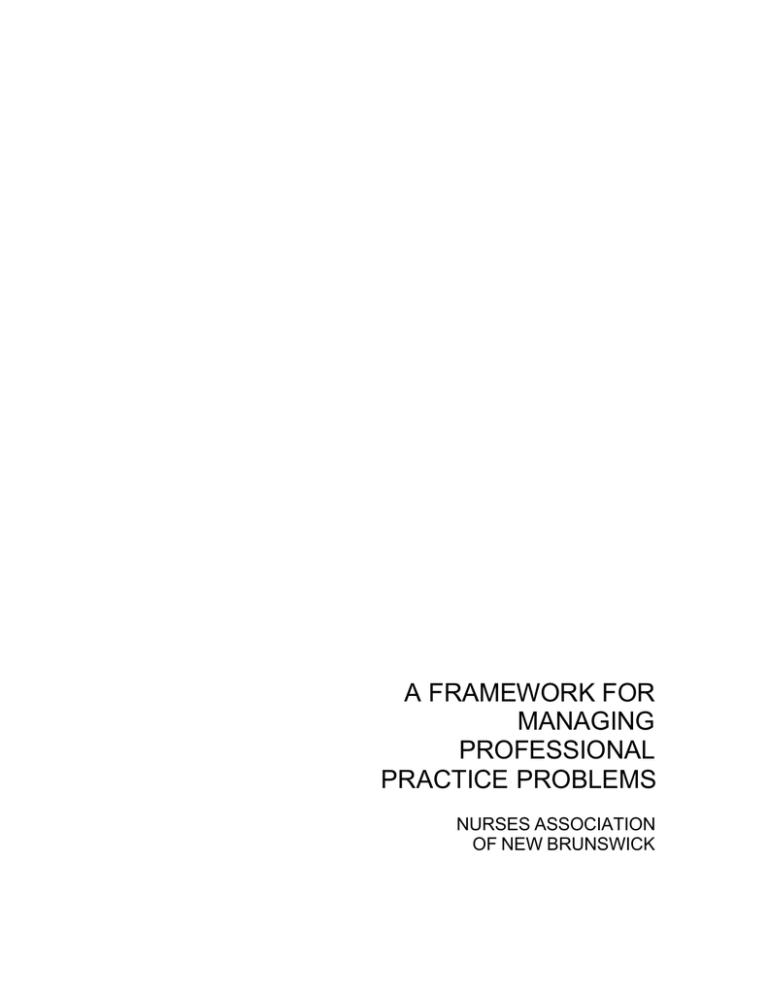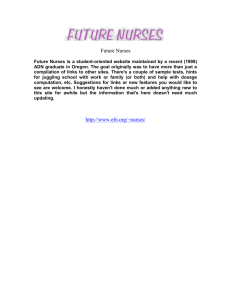
A FRAMEWORK FOR
MANAGING
PROFESSIONAL
PRACTICE PROBLEMS
NURSES ASSOCIATION
OF NEW BRUNSWICK
OUR MANDATE
The Nurses Association of New Brunswick is a professional organization
that exists to protect the public and to support nurses by promoting and
maintaining standards for nursing education and practice, and
by advocating for healthy public policy.
The Nurses Association of New Brunswick endorses the principles of selfregulation, that is, promoting good practice, preventing poor practice and
intervening when practice is unacceptable.
©Nurses Association of New Brunswick, 2009
All rights reserved. No part of this publication may be reproduced or transmitted in any form or by any means,
electronic or mechanical, including photocopying, recording, or by any information storage and retrieval system,
without prior written permission from the publisher.
February 2009
TABLE OF CONTENTS
1. MANAGING PROFESSIONAL PRACTICE PROBLEMS
What is a professional practice problem? ..........................................................1
Examples of professional practice problems .....................................................1
2. FRAMEWORK FOR ACTION
STEP I: Verify the problem ..................................................................................2
STEP II: Communicate the problem ..................................................................2
STEP III: Document the problem .......................................................................3
STEP IV: Resolve the problem ...........................................................................3
RESOURCES ............................................................................................................5
APPENDIX A: Sample correspondence ...............................................................7
REFERENCES ..........................................................................................................8
1. MANAGING PROFESSIONAL PRACTICE PROBLEMS
The goal of nursing practice is to achieve the best possible health outcome for
the client, with no unnecessary exposure to risk or harm. Nurses are accountable
for decisions that are consistent with safe, competent, and ethical practice. As
employees, nurses have a responsibility to work in accordance with accepted
standards, and to appropriately inform their employer when unable to meet those
standards. Nurses also have a responsibility “to respond to and report
professional practice problems and promote a practice environment that supports
professional responsibility and accountability” (Standards of Practice for
Registered Nurses, 2005). In responding to potentially unsafe work situations,
each nurse is expected to consider the specific circumstances of the situation,
the professional obligations as well as any contractual obligations with the
employer (NANB & NBNU, 2007).
This document offers a framework to support RNs in meeting this responsibility.
What is a professional practice problem?
A professional practice problem is distinguishable from employment or personal
problems in the workplace. Problems of a professional practice na ture are
identified as any situation in the workplace that:
• has or could place clients at risk;
• interferes with a nurse’s ability to practice in accordance with the Standards of
Practice for Registered Nurses, the Code of Ethics for Registered Nurses,
Nurses Act or other legislation, workplace policies, procedures or other relevant
standards and guidelines; and
• is beyond the ability of an individual nurse to resolve.
Examples of professional practice problems are:
•
•
•
•
•
•
staffing that is inadequate in number, education or experience;
lack of written policies to provide direction for nursing practice;
lack of appropriate supplies or equipment;
lack of access to essential medical or other health care professionals;
inadequate communication/documentation systems to support decisionmaking about client care; and
conflict between professionals.
2. FRAMEWORK FOR ACTION
The following framework details a four-step process that will assist RNs to
identify, evaluate, communicate and resolve professional practice problems.
STEP I: Identify/verify the problem
The following can help nurses isolate and clarify the professional practice
problem:
• Does the situation present risks to clients? If yes, what specifically are the risks
or potential impacts if the situation is not corrected?
• Does the situation interfere with the nurse’s ability to practice according to
established professional or workplace standards, policies/procedures,
guidelines? Which ones specifically: Standards of Practice for Registered
Nurses, Code of Ethics for Registered Nurses, Nurses Act or other relevant
legislation, specific workplace policies/procedures?
• Does the situation interfere with the nurse’s ability to act competently?
• Is this a recurring situation?
• Are there common factors contributing to the situation and if so, what are they:
people, settings, situations?
• Do other RNs think that corrective measures are needed?
• Does the absence of a workplace policy/procedure/guideline contribute to
this problem?
FRAMEWORK FOR ACTION
STEP II: Communicate the problem
Once a professional practice problem has been confirmed, the established lines
of communication in the workplace must be used to communicate the problem so
that it can be reviewed and action taken to address the issue. What follows is a
suggested course of action:
• contact immediate manager/supervisor to discuss the problem;
• present the facts and explain concerns, in the context of what is believed poses
a risk to clients and/or impedes the ability to practice according to established
standards;
• categorize the practice problem as one of the following: competence,
documentation, standards, staffing, leadership, policies/procedures,
communication, legal/ethical issues, professional responsibility/accountability,
physical plant, equipment/supplies,
• support concerns with relevant information; and
• offer to participate in resolving the situation.
STEP III: Document the problem
In follow up to discussion on the issue, prepare a detailed written statement
describing the:
• situation and factors that contribute to making it a professional practice
problem;
• date, time, place and who was involved;
• impact, or potential impact, on clients and/or on nursing practice;
• standards, policies/procedure or guidelines which were not being met;
• actions taken in relation to the problem; and
• resolution/corrective action proposed.
Workplaces may have designated forms for this purpose such as incident or
variance reports. Where these exist, a nurse should use these forms to
document the situation. If there are no such reporting tools in the workplace, then
a letter or memo format (see sample in appendix) is appropriate. A nurse may
choose to complete the workplace form and enclose additional documentation
through a letter or memo. Ensure that written communication is signed, dated,
marked confidential and includes a request for a response by a specific date,
which is reasonable when considering the degree of urgency of the problem.
NOTE: Remember to keep a copy of this correspondence for your records.
If a nurse does not receive a response by the requested date, inquire as to what
progress is being made. If action is not being taken:
• send a second letter/memo to the same individual, stating this is in follow up to
the earlier letter, which is enclosed in this correspondence; forward copies to the
next highest level of management in the organization (this would normally be the
individual to whom immediate manager/supervisor reports) and ensure a copy of
this correspondence is kept on record; and
• keep a detailed record of all conversations and written communications
surrounding this issue, actions/decisions taken and any results.
FRAMEWORK FOR ACTION
STEP IV: Resolve the problem
• Participate in resolving the problem. Suggest appropriate resources and
propose constructive solutions.
• Professional practice problems should be communicated and documented each
time they occur. Continue to communicate your concerns if clients continue to be
at risk or professional practice standards are violated, and work constructively
until the problem is resolved.
• If a nurse has exhausted all channels within their organization and the
problem has still not been resolved, contact an NANB Practice Advisor/
Consultant to receive more information on how to approach the problem
for resolution at 1 800 442-4417/(506)458-8731
• The registered nurse may also involve the New Brunswick Nurses Union,
if it is appropriate to do so.
The following flow chart outlines the four (4) step process.
Responding to professional practice problems: 4 steps
Identify/verify
??
Communicate
Document
Resolve
RESOURCES
Publications
The following documents or resources may be of assistance in managing
Professional practice problems:
•
Nurses Act,(1984)
http://www.nanb.nb.ca/pdf_e/Publications/General_Publications/NursesAc
t_E&F.pdf
•
Code of Ethics for Registered Nurses (CNA, 2008)
http://www.nanb.nb.ca/pdf_e/Publications/General_Publications/CNA%20
Code%20of%20Ethics.pdf
•
Standards of Practice for Registered Nurses(NANB, 2005)
http://www.nanb.nb.ca/pdf_e/Publications/General_Publications/Standards
ofRegisteredNursesE.pdf
•
Working Understaffed: Professional and Legal Considerations (NANB and
NBNU, 2007)
http://www.nanb.nb.ca/pdf_e/Publications/General_Publications/Working%
20Understaffed%20Brochure.pdf
•
Framework for a Quality Professional Practice Environment for Registered
Nurses(NANB, 2005)
http://www.nanb.nb.ca/pdf_e/Publications/Position_Statements/POSITION
_STATEMENTS_PDF/FrameworkQualityProfessinalPracticeEnvE.pdf
•
Patient Safety (CNA, 2004)
http://www.nanb.nb.ca/pdf_e/Publications/Position_Statements/POSITION
_STATEMENTS_PDF/CNAPatientSafetyE.pdf
•
Workplace Policies and Procedures
Other NANB documents can be obtained online at www.nanb.nb.ca.
CONSULTATIONS
•
Contact an NANB Practice Advisor/Consultants for support in defining the
problem, the appropriate resources and approach for problem resolution
(1 800 42-4417/(506)458-8731 or by email at nanb@nanb.nb.ca)
•
Canadian Nurses Protective Society for free consultation on legal/liability
issues (1 800 267-3390)
APPENDIX A: Sample Correspondence
CONFIDENTIAL
Date (day/month/year)
Jane Doe, RN
Program Manager, Surgery
ABC Health Authority
Somewhere, NB
Dear Ms. Doe:
This letter is in follow up to our discussion on (date) concerning the professional practice
problem related to (specify the situation) with the …. (give specifics as to where this
problem is evident, for example, the specific program/unit).
I have observed (been witness to/experienced) the following…... (detail the issue) on
(where, when, who was present/involved).
This is a recurring problem which, if left unresolved, poses a risk to clients by… (details) -orcompromises nurses’…. ability to practice according to professional standards (specify
which ones)/workplace policy/procedure (specify which ones).
I am requesting that …...(specify what action is expected to be required) be taken to bring a
quick resolution to this problem -or- that the Professional Practice Committee review and
propose a solution to this problem.
I would appreciate a response by (date) relative to the action being taken to respond to my
concerns.
Thank you for your assistance in this matter. I look forward to the opportunity, where
possible, to participate in the resolution of this professional practice problem.
Sincerely,
REFERENCES
Canadian Nurses Association (2008). The Code of Ethics for Registered Nurses.
Ottawa: Author
Nurses Association of New Brunswick (2005). Standards of Practice for
Registered Nurses. Fredericton: Author.
Nurses Association of New Brunswick and New Brunswick Nurses Union (2007).
Working Understaffed: Professional and Legal Considerations. Fredericton:
Author


